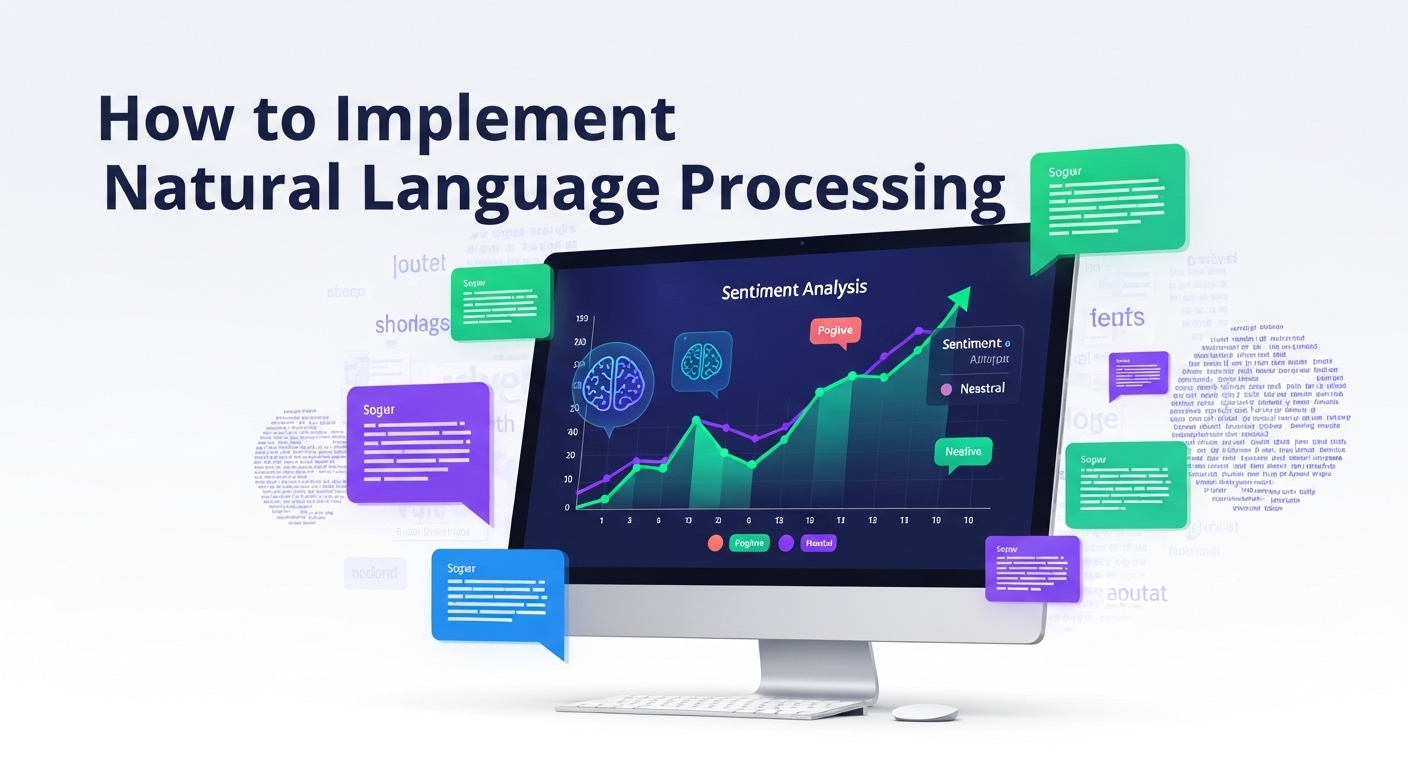Natural language processing implementation refers to the process of integrating NLP technologies into existing systems or building new applications that can understand, interpret, and generate human language. This involves selecting appropriate algorithms, preparing data, training models, and deploying solutions that can process text or speech effectively.
The implementation process requires careful planning, technical expertise, and a clear understanding of your specific use case requirements. Whether you’re building a customer service chatbot, sentiment analysis system, or document classification tool, the fundamental implementation principles remain consistent.
Step 1: Define Your Natural Language Processing Requirements
Before diving into natural language processing implementation, you must clearly define what you want to achieve. Start by identifying specific business problems that NLP can solve:
- Customer Support Automation: Implement chatbots to handle routine inquiries
- Content Analysis: Analyze customer feedback, reviews, or social media mentions
- Document Processing: Extract information from contracts, invoices, or reports
- Language Translation: Provide multilingual support for global operations
Create a detailed requirements document that outlines:
- Input data types (text, speech, documents)
- Expected output formats
- Performance benchmarks
- Integration requirements
- Scalability needs
Step 2: Choose the Right NLP Tools and Frameworks
Selecting appropriate tools is crucial for successful natural language processing implementation. Consider these popular options:
Framework | Best For | Programming Language | Complexity |
spaCy | Production applications | Python | Medium |
NLTK | Research and education | Python | High |
Transformers | Pre-trained models | Python | Medium |
Stanford NLP | Academic research | Java/Python | High |
Azure Cognitive Services | Cloud-based solutions | Multiple | Low |
Open-Source vs. Commercial Solutions
Open-Source Tools:
- Greater customization flexibility
- No licensing costs
- Active community support
- Requires more technical expertise
Commercial Platforms:
- Faster implementation
- Enterprise support
- Pre-built integrations
- Higher ongoing costs
For beginners, cloud-based services like Google Cloud Natural Language API or Amazon Comprehend offer excellent starting points for natural language processing implementation.
Step 3: Prepare and Process Your Data
Data preparation is the foundation of effective natural language processing implementation. Follow these essential steps:
Data Collection
Gather relevant text data from various sources:
- Customer emails and chat logs
- Product reviews and feedback
- Internal documents and reports
- Social media posts and comments
Data Cleaning and Preprocessing
Clean your data to improve model performance:
- Text Normalization: Convert text to lowercase and remove special characters
- Tokenization: Break text into individual words or phrases
- Stop Word Removal: Filter out common words like “the,” “and,” “or”
- Stemming/Lemmatization: Reduce words to their root forms
Data Annotation
For supervised learning tasks, properly annotate your data:
- Label sentiment (positive, negative, neutral)
- Tag named entities (person, organization, location)
- Classify document categories
- Mark grammatical parts of speech
Step 4: Build and Train Your NLP Model
The model development phase of natural language processing implementation involves several critical decisions:
Choose Your Approach
Rule-Based Systems:
- Use predefined linguistic rules
- Highly interpretable results
- Limited scalability
- Best for specific, well-defined tasks
Machine Learning Models:
- Learn patterns from training data
- Better generalization
- Require substantial training data
- More complex to implement
Deep Learning Models:
- Handle complex language patterns
- State-of-the-art performance
- Require significant computational resources
- Less interpretable results
Model Training Process
- Split your data into training (70%), validation (15%), and test (15%) sets
- Select appropriate algorithms based on your task requirements
- Train your model using the prepared training data
- Validate performance using metrics like accuracy, precision, and recall
- Fine-tune hyperparameters to optimize results
Popular NLP Model Types
Task Type | Recommended Models | Use Cases |
Text Classification | Naive Bayes, SVM, BERT | Spam detection, sentiment analysis |
Named Entity Recognition | CRF, BiLSTM-CRF, spaCy | Information extraction |
Language Translation | Transformer, T5 | Multilingual applications |
Question Answering | BERT, RoBERTa | Customer support systems |
Step 5: Deploy and Monitor Your NLP System
Successful natural language processing implementation extends beyond model development to include deployment and ongoing maintenance.
Deployment Strategies
Cloud Deployment:
- Scalable infrastructure
- Managed services
- Pay-per-use pricing
- Automatic updates
On-Premises Deployment:
- Complete data control
- Custom security measures
- Higher upfront costs
- Manual maintenance required
Integration Considerations
Integrate your NLP system with existing infrastructure:
- APIs: Expose NLP functionality through RESTful APIs
- Batch Processing: Handle large volumes of data offline
- Real-Time Processing: Provide immediate responses for user interactions
- Database Integration: Store and retrieve processed results efficiently
Performance Monitoring
Implement comprehensive monitoring to ensure optimal performance:
- Accuracy Metrics: Track model performance over time
- Response Times: Monitor system latency and throughput
- Error Rates: Identify and address processing failures
- Resource Usage: Optimize computational efficiency
Best Practices for NLP Implementation Success
- Start Small and Scale Gradually: Begin your natural language processing implementation with a focused use case. Prove value with a minimum viable product before expanding to more complex scenarios.
- Invest in Quality Data: High-quality training data directly impacts model performance. Allocate sufficient resources for data collection, cleaning, and annotation processes.
- Plan for Model Updates: Language evolves continuously, requiring regular model updates. Establish processes for retraining models with new data and deploying updated versions.
- Consider Ethical Implications: Address bias in your NLP models by using diverse training datasets, testing across different demographic groups, implementing fairness metrics. and regular bias auditing.
Common Implementation Challenges and Solutions
- Insufficient Training Data: Use transfer learning with pre-trained models like BERT or GPT to leverage existing knowledge.
- Language Ambiguity: Implement context-aware models and provide clear input guidelines to users.
- Performance Issues: Optimize models through techniques like quantization, pruning, and efficient architectures.
- Integration Complexity: Use established NLP platforms and follow API-first design principles.
Future-Proofing Your NLP Implementation
Stay current with emerging trends in natural language processing implementation:
- Large Language Models (LLMs): Explore integration with models like GPT-4 and Claude
- Multimodal Processing: Combine text with images and audio for richer understanding
- Edge Computing: Deploy lightweight models directly on user devices
- Conversational AI: Develop more sophisticated dialogue systems
Measuring ROI and Success Metrics
Track the business impact of your natural language processing implementation:
Quantitative Metrics
- Processing time reduction
- Cost savings from automation
- Accuracy improvements
- User satisfaction scores
Qualitative Benefits
- Enhanced customer experience
- Improved decision-making capabilities
- Reduced manual workload
- Competitive differentiation
Conclusion
Natural language processing implementation requires careful planning, appropriate tool selection, and ongoing optimization. By following these five essential steps—defining requirements, choosing tools, preparing data, building models, and deploying systems—you can successfully integrate NLP capabilities into your organization.
Successful implementation is an iterative process. Start with clear objectives, use proven tools and frameworks, invest in quality data preparation, and maintain a focus on continuous improvement. With proper execution, natural language processing implementation can transform how your organization handles textual data and interacts with customers.
The key to success lies in understanding your specific use case, selecting appropriate technologies, and maintaining a commitment to ongoing optimization and improvement.











